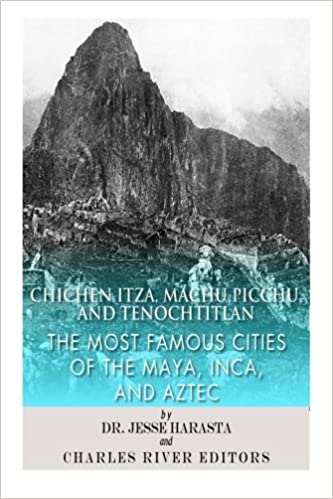Chichen Itza, Machu Picchu, and Tenochtitlan: The Most Famous Cities of the Maya, Inca, and Aztec

https://CourseLala.com
English | 2013 | ISBN: 1494368242 | 120 pages | EPUB | 4 MB
*Includes pictures of the sites and depictions of important people and events.
*Explains the history of the sites and the theories about their purpose.
*Describes the layout of the ancient cities, their important structures, and the theories about the buildings' uses.
*Includes footnotes and bibliographies for further reading.
Chichen Itza was inhabited for hundreds of years and was a very influential center in the later years of Maya civilization. At its height, Chichen Itza may have had over 30,000 inhabitants, and with a spectacular pyramid, enormous ball court, observatory and several temples, the builders of this city exceeded even those at Uxmal in developing the use of columns and exterior relief decoration. Of particular interest at Chichen Itza is the sacred cenote, a sinkhole was a focus for Maya rituals around water. Because adequate supplies of water, which rarely collected on the surface of the limestone based Yucatan, were essential for adequate agricultural production, the Maya here considered it of primary importance. Underwater archaeology carried out in the cenote at Chichen Itza revealed that offerings to the Maya rain deity Chaac (which may have included people) were tossed into the sinkhole. Why Maya cities were abandoned and left to be overgrown by the jungle is a puzzle that intrigues people around the world today, especially those who have a penchant for speculating on lost civilizations.
In 1911, American historian Hiram Bingham publicized the finding of what at the time was considered a “lost city” of the Inca. Though local inhabitants had known about it for century, Bingham documented and photographed the ruins of a 15th century settlement nestled along a mountain ridge above the Urubamba Valley in Peru, placed so perfectly from a defensive standpoint that it’s believed the Spanish never conquered it and may have never known about it. Today, of course, Machu Picchu is one of South America’s best tourist spots, and the ruins have even been voted one of the Seven New Wonders of the World. But even though Machu Picchu is now the best known of all Incan ruins, its function in Incan civilization is still not clear. Some have speculated that it was an outpost or a frontier citadel, while others believe it to be a sanctuary or a work center for women. Still others suggest that it was a ceremonial center or perhaps even the last refuge of the Incas after the Spanish conquest. One of the most theories to take hold is that Machu Picchu was the summer dwelling of the Inca’s royal court, the Inca’s version of Versailles. As was the case with the renaming of Mayan and Aztec ruins, the names given to various structures by archaeologists are purely imaginary and thus not very helpful; for example, the mausoleum, palace or watchtower at Machu Picchu may have been nothing of the sort.
Mexico City is now easily the largest city in the Western Hemisphere, trailing only Tokyo internationally, but unlike the other great cities of the Americas, Mexico City is not a new place. Mexico City instead has much in common with cities like London, Delhi or Cairo in the East in that it is an ancient city dating back centuries before the arrival of Columbus in Hispaniola. For, while much (including the name) has changed, Mexico City is the mighty Tenochtitlan, capital of the Aztec Empire and the great American metropolis of the Spanish Empire. There has been no break in occupation, and despite much devastation in the Conquest, the city was never fully destroyed.
What the conquistadores encountered in Tenochtitlan was entirely unexpected: one of the world's greatest cities, teeming with over 200,000 people, built on an island on a lake and connected to the shore by a number of long, broad stone causeways. On the water itself were remarkable floating gardens, on surrounding shorelines were sprawling suburbs, and behind them was a dramatic wall of mountain peaks.
